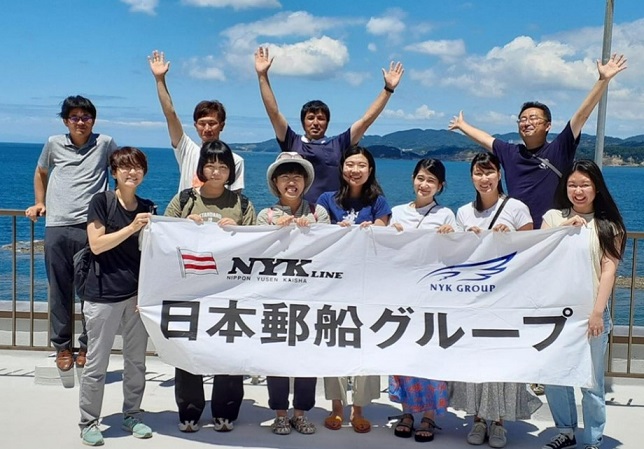Mar. 31, 2023
NYK Sponsors Endangered Sea Turtle Research
NYK has sponsored the Kishu Minabe Sea Turtle Research Project conducted by the NPO Earthwatch Japan* for a seventh consecutive year.
Minabe-cho in Wakayama Prefecture is where most loggerhead sea turtles** lay their eggs on the main island of Japan. This research project started in 2016 to study sea turtle behavior patterns and keep the turtles free of danger by mapping the sea turtles as they migrate through the vast ocean.
This year, for the first time in two years, NYK Group employees volunteered at Minabe-cho, assisting in the identification of loggerhead turtles that had come ashore to lay eggs, and measuring the length and width of the turtles’ shells.
The locations of two loggerhead sea turtles named “Umi-chan No. 4,” a returning turtle, and “Hana-chan No. 4,” a new turtle, are provided on the in-house portal site along with comments by Dr. Yoshimasa Matsuzawa, the project’s chief researcher.
After spawning, "Hana-chan No. 4" headed west-southwest in a straight path toward Cape Muroto, and then made a clockwise half-circumnavigation of the Pacific Ocean on the southeast side of western Japan until the transmission was interrupted 10 kilometers offshore south of Tanegashima. On the other hand, "Umi-chan No. 4" typically remained somewhat near the shore.

From left, Hana-chan No. 4’s movement, Umi-chan No. 4’s movement
The site helps NYK Group employees deepen their interest in the marine environment.
The NYK Group will continue to actively engage in environmental conservation efforts, including activities to preserve the marine environment and biodiversity.

Comment by the project's chief researcher, Yoshimasa Matsuzawa
Currently, the number of loggerhead turtles laying eggs in Japan has declined significantly. In Senrihama, Minabe-cho, spawning declined from 350 confirmed in 1990 to 31 in 2021. 2022 saw a slight rebound, but only 49. On the other hand, the return rate of spawning turtles is also poor. Even after taking into account the shedding of tags, about 70% of the turtles in Minabe-cho will never return. Since females stick to certain beaches, this means a high mortality rate after spawning. To improve the return rate, the most important issue is to clarify where and what threats female loggerheads are exposed to after laying eggs. In this sense, the accumulation of data through continued satellite tracking by this project is expected to play a vital role in the conservation of this species in the future.
* Earthwatch Japan
Earthwatch, a non-profit organization established in 1971 in Boston, is an international nongovernmental organization. It provides researchers with both human and financial support for overseas field research and surveys. Volunteers dispatched all over the world by Earthwatch have taken active roles at cutting-edge scientific sites, receiving instruction from world-class scientists. Earthwatch Institute - Japan was established in 1993 to promote Earthwatch activities in Japan.
https://www.earthwatch.org
** Loggerhead sea turtle
The loggerhead sea turtle is listed on the IUCN Red List of Threatened Species due to shore development, encroachment, and fishing nets.
The news on this website is as of the date announced and may change without notice.